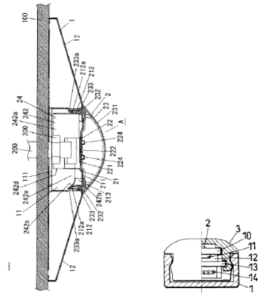Japanese Patent Case Summary: 2023 (Gyo-Ke) No. 10002 – Intellectual Property High Court (April 25, 2024)
“Light Source Unit and Illumination Fixture”
Overview:
This case concerns an invalidation trial, in which the decision concluding that “the request for this trial is without merit” was revoked.
► Link to a summary and full text of the trial decision (Japanese)
Main Issue:
Whether a part of the differences between the invention of the present case and the invention of plaintiff’s exhibit 3-1 acknowledged by the trial decision can be considered as a difference, and whether a person skilled in the art could easily have conceived of the configurations of the other differences acknowledged by the trial decision on the basis of the invention of plaintiff’s exhibit 3-1 and the well-known conventional art.
Summary:
Upon comparing the invention of the present case and the invention of plaintiff’s exhibit 3-1, although the trial decision states that “the ‘insulating plate 13’ of the latter and the ‘attachment member 21’ of the former are similar in that they are both ‘members,’” in the determination for Difference 1-1-3(1), it acknowledges and determines that “in the invention of plaintiff’s exhibit 3-1, the ‘insulating plate 13’ is for attaching a substrate 10 to a lid portion 3, and the member for attaching to the fixture body 1 is the ‘lid portion 3.’” The trial decision is thus based on the assumption that, in Invention 1 of the present case, the presence of a structure interposed between the “fixture body 1” and the “attachment member 21” that contributes to their attachment is excluded.
However, as recognized in the acknowledged gist of the invention of the present case, the invention of the present case includes a structure interposed between the “fixture body 1” and the “attachment member 21” that contributes to their attachment, and it cannot be interpreted that the presence of such a structure is excluded.
Based on the above, the invention of the present case does not exclude an attachment structure in which the “lid portion 3” is interposed between the “insulating plate 13” and the “attachment base 1” such as that in the invention of plaintiff’s exhibit 3-1. Additionally, since the substrate 10, which has the LED 2 arranged thereon, is arranged on the “insulating plate 13” in the invention of plaintiff’s exhibit 3-1, the LED 2 cannot be arranged on the “attachment base 1” if there is no “insulating plate 13,” and thus, it is considered that the “insulating plate 13” corresponds to “the member for attaching the LED substrate 22 to the fixture body 1.”
Consequently, when the invention of the present case is compared with the invention of plaintiff’s exhibit 3-1, it cannot be said that Difference 1-1-3(1) is a difference.
Next, Difference 2-1-3(1) states that in the invention of the present case, the cover member 23 “has diffusivity,” whereas although the invention of plaintiff’s exhibit 3-1 is “made of a transparent insulating material such as acrylic resin or glass,” is it not clear whether it has diffusivity. It is well-known art that the cover member 23 of an LED lighting fixture has diffusivity, and thus, it would be easy for a person skilled in the art to conceive of appropriately employing this for the invention of plaintiff’s exhibit 3-1 to configure the invention of the present case according to Difference 2-1-3(1).
Consequently, it is considered that it would have been easy for a person skilled in the art to invent the invention of the present case on the basis of the invention of plaintiff’s exhibit 3-1, and thus, the trial decision of this case contains an error in the assessment of inventive step that affected the conclusion.
A similar determination has been made with respect to Invention 5 of the present case as with the invention of the present case.
Invention of Present Case Invention of Plaintiff’s Exhibit 3-1

Comments:
The defendant argued that the “attachment member 21” of the invention of the present case is specified as a member for directly attaching the LED substrate 22 to the fixture body 1 according to the wordings of the claims, and that there is no error in the determination on this point in the present case. However, the invention of the present case does not specify the specific configuration for attaching the “attachment member 21” to the fixture body 1, and it was considered that a person skilled in the art could adopt any configuration for attaching the “attachment member 21” to the fixture body 1 based on the technological level. It was also considered that an embodiment in which the cover member 23 is interposed is not excluded, and thus the defendant’s argument was not accepted.
Hiroshi ABE
